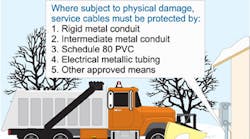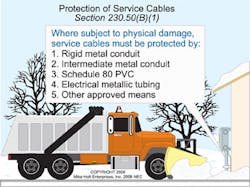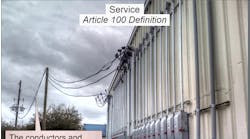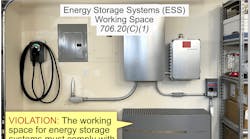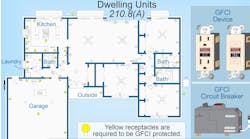Looking at Fig. 230.1 in the NEC, we can see that the second and third major areas of Art. 230 provide requirements for service entrance conductors (Part IV) and service equipment (Parts V, VI, and VII).
Service entrance conductors
Before you begin a service installation, determine which conductors are actually part of the service (line side of the service equipment) rather than feeders and branch circuits (load side of the service equipment).
Although each service drop or service lateral can supply only one set of service entrance conductors [230.40], there are five exceptions:
- Exception No. 1: A building with more than one occupancy can have service entrance conductors for each occupancy. This exception commonly applies to strip malls and even to duplexes, triplexes, and other multiple-family buildings (e.g., apartment houses) to allow locating metering equipment at or near the end of the service drop or service lateral instead of at multiple locations. The rules on the location and grouping of service disconnecting means in 230.71 and 230.72 still apply.
- Exception No. 2: Service entrance conductors can supply two to six service disconnecting means as permitted in 230.71(A).
- Exception No. 3: A single-family dwelling unit with a separate structure, such as a garage, can have one set of service entrance conductors run to each structure from a single service drop or lateral.
- Exception No. 4: A two-family dwelling or multifamily dwelling can have one set of service entrance conductors installed to supply the circuits covered in 210.25.
- Exception No. 5: One set of service entrance conductors connected to the supply side of the normal service disconnecting means can supply standby power systems, fire pump equipment, fire and sprinkler alarms, and alternate power sources like fuel cells and solar photovoltaic systems [230.82(5) and (6)].
Size and rating
Service entrance conductors must have sufficient ampacity for the loads, per Parts III, IV, or V of Art. 220 [230.42].
Before applying any adjustment or correction factors, size the service entrance conductors at least 125% of the continuous loads, plus 100% of the noncontinuous loads. Base your calculations on the terminal temperature rating ampacities listed in Table 310.16 [110.14(C)].
Size the neutral conductor to carry the maximum unbalanced load per 220.61. It also can't be smaller than required by 250.24(C) [230.42(C)].
Wiring methods
You can use any of the 16 wiring methods listed in 230.43 for installing service conductors. Follow the applicable Chapter 3 requirements for the wiring method you choose (for example, Art. 358 for EMT). You can also use cable trays, if they contain only service entrance conductors — or if they have a barrier that separates the service conductors from the feeders or branch circuits [230.44].
Splices and taps must comply with 110.14, 300.5(E), 300.13, and 300.15 [230.46].
Protection from physical damage
Protect underground conductors from physical damage per 300.5 [230.50(A)]. For all other conductors, install in IMC, RMC, Schedule 80 PVC, or EMT (per Arts. 342, 344, 352, and 358, respectively) or use other means approved by the AHJ (Fig. 1).
Raceways for overhead service drops must have a weatherhead [230.54] — so must service cables. However, you can form SE cable into a gooseneck and tape it with self-sealing weather-resistant thermoplastic. Be sure to support the cables within 1 ft of the weatherhead, raceway connections, or enclosure — and at intervals not exceeding 30 in. [230.51].
Locate service heads and goosenecks above the point of attachment, per 230.26. Where it's impractical to locate the service head above the point of attachment, locate within 2 ft of the point of attachment [230.54(C)].
Service heads must provide a bushed opening, and ungrounded conductors must be in separate openings. Drip loop conductors must be below the service head or below the termination of the service entrance cable sheath. Arrange service drops and service entrance conductors to prevent water from entering service equipment.
Service disconnect
The service disconnecting means must consist of either a manually operated switch or a power-operated switch or circuit breaker also capable of being operated manually [230.76]. It must open all service entrance conductors from the premises wiring of the structure [230.70].
A shunt-trip button does not qualify as a service disconnect because it doesn't meet any of the above requirements.
Install the service disconnecting means at a readily accessible location nearest the point of service conductor entry (either inside or outside the structure) [230.70(A)(1)]. In a multiple-occupancy building, each occupant must have access to the service disconnecting means [230.72(C)]. However, if electrical maintenance is provided by continuous building management, the service disconnecting means can be accessible only to building management personnel.
Because service entrance conductors don't have short circuit or ground-fault protection, they must be limited in length when installed inside a building. Some local jurisdictions have specific length requirements (Fig. 2).
You can have a maximum of six service disconnects for each service permitted by 230.2, or each set of service entrance conductors permitted by 230.40 Ex 1, 3, 4, or 5 [230.71]. This is per service, not per building. Make sure these are grouped per 230.72.
Disconnect rating
The service disconnecting means must have an ampere rating of at least the calculated load per Art. 220 [230.79], and the rating of the disconnecting means must be at least:
- 15A for installations consisting of a single branch circuit
- 30A for installations consisting of two 2-wire branch circuits
- http://beta.ecmweb.com/code-basics/electrical-services-part-2 for all other installations.
- 100A for a one-family dwelling.
Disconnect supply side connections
Don't connect any electrical equipment to the supply side of the service disconnect, except for [230.82]:
Service equipment overcurrent protection
The NEC doesn't require you to provide short circuit or ground-fault protection for service conductors, but the feeder overcurrent device provides overload protection for the service conductors.
Each ungrounded service conductor must have overload protection at the point where the service conductors terminate [230.90 and 240.21(D)] (Fig. 4).
The rating of the overcurrent device must not exceed the ampacity of the conductors. See the five exceptions noted in 230.90(A).
Equipment ground-fault protection
You must provide equipment ground-fault protection for each service disconnecting means rated 1,000A or more, if it's supplied by a 4-wire, 3-phase, 277/480V wye-connected system [230.95]. The rating of the service disconnecting means is considered to be the rating of the largest fuse that can be installed or the highest continuous current trip setting of a circuit breaker.
The NEC prohibits ground-fault protection of equipment for fire pumps [695.6(H)], and doesn't require it for emergency systems [700.26] or legally required standby systems [701.17].
Article 100 defines “Ground-Fault Protection of Equipment” as a system intended to provide protection of equipment from ground faults by opening the overcurrent device at current levels less than those required to protect conductors from damage. This type of protective system is intended to protect connected equipment, not people. See 215.10 for similar requirements for feeders.
To install a service correctly, you must comply with all of Art. 230, and that can seem overwhelming initially. If you first address the conductors and then the equipment, you'll find it easier to get your head around these requirements for any given project.
If you're developing the work breakdown structure (WBS) for a service installation project, refer to Fig. 230.1 in the NEC during that process. This will help you keep your WBS useful, rather than missing a key task or becoming overly detailed.
Sidebar: Key Definitions
Service point
The point of connection between the serving utility and the premises wiring.
- Service conductors
The conductors from the service point to the service equipment (the service disconnecting means, not the meter). Service entrance conductors may be either overhead (service drop) or underground (service lateral), or there might not be any at all.
- Service equipment
The necessary equipment, usually consisting of circuit breakers or switches and fuses and their accessories, connected to the load end of service conductors at a structure (or an otherwise designated area) and intended to constitute the main control and cutoff of the electrical supply. Service equipment doesn't include metering components, such as the meter and meter socket enclosure [230.66].
